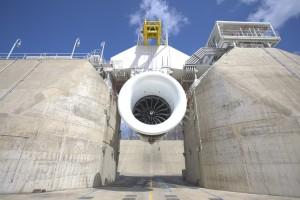 A year ago, GE Aviation began incorporating 3D printed components into their jet engines for the first time ever, retrofitting hundreds of their GE90 engines with 3D printed sensor housings. At that time, the GE90 was the largest jet engine in the world, but today it must relinquish that title with the introduction of the GE9X, a gigantic beast of an engine developed for the new Boeing 777X airplane. Recently, GE fired the engine up and began testing it out in the woods near Peebles, Ohio, the company’s dedicated testing site.
A year ago, GE Aviation began incorporating 3D printed components into their jet engines for the first time ever, retrofitting hundreds of their GE90 engines with 3D printed sensor housings. At that time, the GE90 was the largest jet engine in the world, but today it must relinquish that title with the introduction of the GE9X, a gigantic beast of an engine developed for the new Boeing 777X airplane. Recently, GE fired the engine up and began testing it out in the woods near Peebles, Ohio, the company’s dedicated testing site.
The GE9X sports a front fan with a world record 11-foot (3.35-meter) diameter, but the engine isn’t just bigger than its predecessors. It’s also the most fuel-efficient engine GE has ever produced, and can generate 100,000 pounds of thrust – not the world’s most powerful, but close. (Comparatively, a space shuttle engine produces 375,000 pounds of thrust.) Oh, and it has several 3D printed parts, namely fuel nozzles. Thanks to 3D printing, engineers were able to design complex internal shapes that would have been impossible with other manufacturing techniques. Don’t look for too much detail on those components, though.
“These tunnels and caves are a closely guarded secret,” said Rick Kennedy, a spokesman for GE Aviation. “They determine how the fuel moves through the nozzle and sprays inside the combustion chamber.”
The nozzles also greatly reduce the weight of the engine, as well as the noise level – on a per-pounds-of-thrust basis, it’s the quietest engine GE has ever produced. Then there’s the heat-resistance. The engine’s core consists largely of ceramic matrix composites (CMCs), capable of withstanding temperatures of up to 2,400°F.
“The hotter the engine runs, the more efficient it is.” said Kennedy.
 Also contributing to the engine’s fuel efficiency are 16 fourth-generation carbon fiber fan blades, which push air into an 11-stage high-pressure compressor with a 27:1 pressure ratio – the highest pressure ratio of any commercial engine in service. The GE9X has been in development for several years, and GE has already tested many of the components on their own; this was the first time the full engine was tested, however.
Also contributing to the engine’s fuel efficiency are 16 fourth-generation carbon fiber fan blades, which push air into an 11-stage high-pressure compressor with a 27:1 pressure ratio – the highest pressure ratio of any commercial engine in service. The GE9X has been in development for several years, and GE has already tested many of the components on their own; this was the first time the full engine was tested, however.
“Due to the significant amount of new technologies in the GE9X, we planned the testing program differently,” said GE9X program leader Chuck Jackson. “The early testing informed the design and manufacturing and allowed us to freeze the product definition and test the total engine as soon as possible.”
While the GE9X won’t go into commercial service for a few years yet, GE has already received over 700 orders for the engine from several major airlines. A $10 million investment went into the testing program, which will continue for several months until the aerodynamic, thermal and mechanical characteristics of the engine are verified. The second iteration of the engine will begin undergoing testing next year.
GE has made no secret of the fact that they are very serious about 3D printing; they’ve made several huge investments in the technology over the past two years. Based on the early demand for the GE9X engine, it certainly looks as though those investments are going to pay off. You can see a video of the testing of the GE9X below. Discuss your thoughts on the use of this technology in the GE Jet Engine & 3D Printing forum over at 3DPB.com.
https://youtu.be/nurk_4zpx-s
[Source/Images: GE Reports]
Subscribe to Our Email Newsletter
Stay up-to-date on all the latest news from the 3D printing industry and receive information and offers from third party vendors.
You May Also Like
3D Printing Unpeeled: Biofuel Waste to Filament & Sustainable Photopolymers
I can’t ever remember a day with so many potentially high impact news stories have come out. In one story, we all know that there are problems with the safety...
Finnair Hires AM Craft to 3D Print Plastic Parts for Aircraft Interiors
Riga-based AM Craft, a supplier specialized in 3D printing aviation components and certified under EASA Part 21G, announced a significant achievement today. The company will assist in upgrading Finnair’s A320...
3DPOD Episode 198: High Speed Sintering with Neil Hopkinson, VP of AM at Stratasys
Neil Hopkinson, a pioneering 3D printing researcher, played a pivotal role in developing a body of research that is widely utilized today. He also invented High Speed Sintering (HSS), also...
3D Printing Webinar and Event Roundup: May 12, 2024
Webinars and events are picking up in the AM industry this week! ASTM International continues its Professional Certificate Course and Stratasys continues its advanced in-person trainings, while 3D Systems is...

































